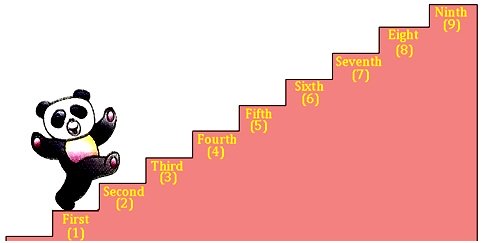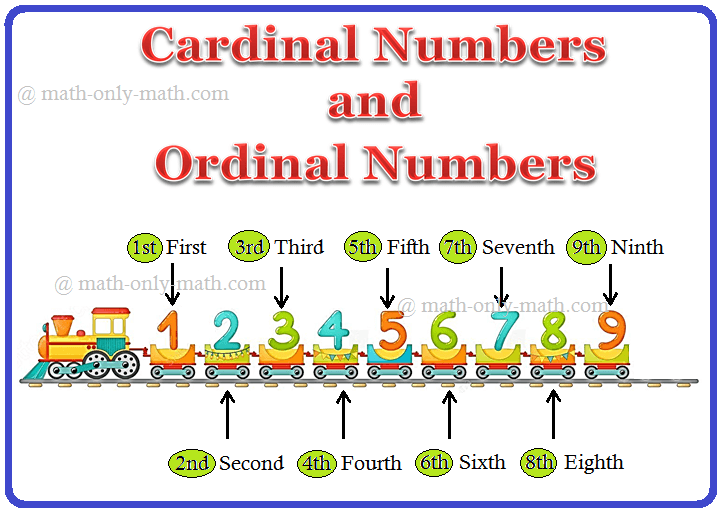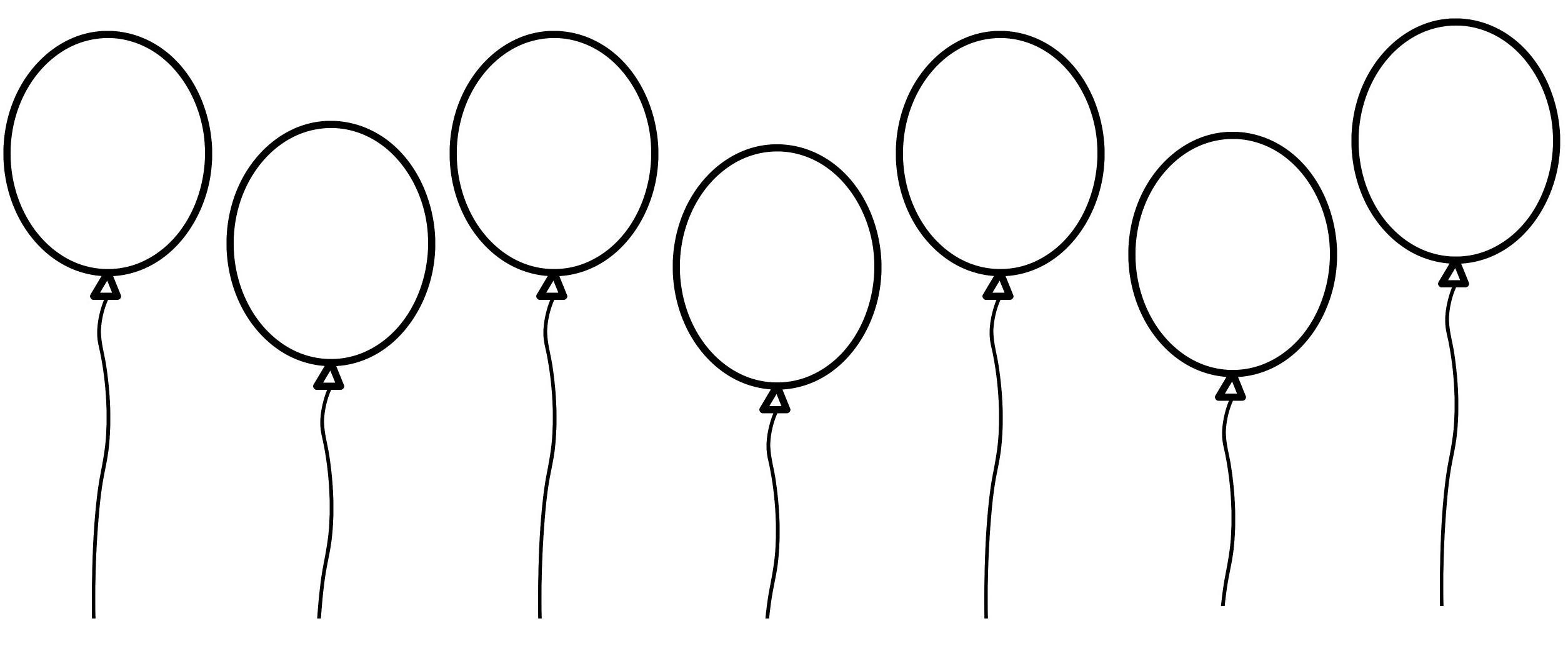Subscribe to our ▶️ YouTube channel 🔴 for the latest videos, updates, and tips.
Cardinal Numbers and Ordinal Numbers
Cardinal numbers and ordinal numbers are explained here with the help of colorful pictures.
We count the number of objects like this:
One, two, three, four, five, six, seven, eight, nine, ten, eleven, ...
The number on which our counting ends tells us the number of objects. Suppose, we have a collection of balls.
So, there are 6 balls in the collection.
The numbers 1,2,3,... which tell us the number of objects or items are called cardinal numbers.
Ordinal Numbers From 1 to 10 Video
Subscribe to our ▶️ YouTube channel 🔴 for the latest videos, updates, and tips.
Now suppose, 5 children are standing in a queue at the bus stop.
We say that:
1. James is first in the queue.
2. Olivia is second in the queue.
3. Sophia is third in the queue.
4. Daniel is fourth in the queue.
5. Nora is fifth in the queue.
The numbers such as first, second, third, fourth, fifth which tell us the position or rank of an object in an ordered collection, are called ordinal numbers.
There are many steps in a staircase as shown in the above figure. The given staircase has nine steps, i.e., 1, 2, 3, 4, 5, 6, 7, 8 and 9.
In the process of climbing up the stairs, we term step Number (1) as the first step, step Number (2) as the second step number (3) as the third step, Number (4) as the fourth step, Number (5) as the fifth step, Number (6) as sixth step, Number (7) as seventh step, Number (8) as eighth step and Number (9) as ninth step. These are also expressed as 1ˢᵗ, 2ⁿᵈ, 3ʳᵈ, 4ᵗʰ, 5ᵗʰ, 6ᵗʰ, ………… etc.
Numbers 1, 2, 3, 4, 5, ……, 9, etc., are called cardinal numbers while 1ˢᵗ, 2ⁿᵈ, 3ʳᵈ, 4ᵗʰ, 5ᵗʰ, 6ᵗʰ, ………… etc., are known as ordinal numbers.
The cardinal numbers express the quantitative property of the numbers while the ordinal numbers express their order. The cardinal numbers express the number of objects in a collection while the ordinal number always expresses one object.
For example, there are five students in a row (cardinal number) and fifth student of the row (ordinal number).
While coming down the stairs the ordinal numbers are changed. The 9ᵗʰ becomes the 1ˢᵗ, the eighth becomes 2ⁿᵈ, the seventh becomes 3ʳᵈ and so on. Thus, ordinal numbers are changed in reverse order, i.e., the last becomes the first, the last but one becomes the second, etc. But the cardinal numbers remain the same.
|
Cardinal numbers showing serial number of steps of staircase |
⇒ 1 2 3 4 5 6 7 8 9 |
|
Ordinal numbers from the front |
⇒ 1st 2nd 3rd 4th 5th 6th 7th 8th 9th |
|
Ordinal numbers from the back |
⇒ 9th 8th 7th 6th 5th 4th 3rd 2nd 1st |
Thus, the ordinal numbers indicate the position of an object from the front or back of any given object.
Let us imagine that, there are seven boys in a row who are numbered as 1, 2, 3, 4, 5, 6 and 7 from one end of the row. These numbers are called cardinal numbers.
For example:
● Ordinal Numbers from 1 to 7: 1st 2nd 3rd 4th 5th 6th 7th
● Ordinal Numbers from 7 to 1: 7th 6th 5th 4th 3rd 2nd 1st
Now if we take the position of each boy from boy number (1). The position of each boy is indicated by ordinal numbers. These are from left to right as 1st, 2nd, 3rd, 4th, 5th, 6th, 7th and from right to left as 7th, 6th, 5th, 4th, 3rd, 2nd, 1st.
Thus, from both sides the position of each boy may be indicated by ordinal numbers.
REPRESENTATION OF ORDINAL NUMBERS
In figures, the ordinal numbers are indicated by counting numbers but we suffix two letters every time. The first, second and third are shown by adding the letters 'st', 'nd' and 'rd' respectively. All the other ordinal numbers are shown by adding 'th'.
The first ten ordinal numbers are given below in words and figures:
|
Ordinal Numbers |
Representation |
|
First |
1st |
|
Second |
2nd |
|
Third |
3rd |
|
Fourth |
4th |
|
Fifth |
5th |
|
Sixth |
6th |
|
Seventh |
7th |
|
Eighth |
8th |
|
Ninth |
9th |
|
Tenth |
10th |
Ordinal numbers tell us the position number of objects.
The Meaning of Ordinals:
The drill teacher asked some 5 boys to stand in a line. The 5 boys stood in a line in the following order :- Peter, Ramesh, John, Ahmed and David.
Here Peter is the first boy in the line.
Ramesh is the second boy in the line.
John is the third boy in the line.
Ahmed is the fourth boy in the line.
David is the fifth boy in the line.
Peter is the first boy and David is the last boy. In between, there are Ramesh, John and Ahmed. When we talk of Ramesh, we say he is the second boy in the line, and when we talk of John, we say he is the third boy in the line and so on.
Here first, second, third, fourth and fifth are ordinal numbers, corres- ponding to 1, 2, 3, 4, 5. We write
first as 1st,
second as 2nd,
third as 3rd,
fourth as 4th,
fifth as 5th,
sixth as 6th.
Who stood first in the Arithmetic Test?
Rama stood third in the English Test.
David was second in the Drawing Test.
What is the meaning of first, second and third here?
First, second, third are the ordinal numbers.
Numbers 1, 2, 3... are called counting numbers or cardinal numbers.
Numbers 1st (first), 2nd (second), 3rd (third)... are called ordinal numbers.
Ordinal numbers tell us the position of objects or people when placed in order.
Now, look at the fruits shown alongside.
If we count the fruits from left to right, the first fruit is apple, the second fruit is watermelon and the third fruit is pineapple. But if we count the fruits from right to left, the first fruit is pineapple, the second fruit is watermelon and the third fruit is apple.
Again, look at the picture below.
1st (First) ➡ 2nd (Second) ➡ 3rd (Third) ➡ 4th (Fourth)
4th (Fourth) ⬅ 3rd (Third) ⬅ 2nd (Second) ⬅ 1st (First)
|
Starting from left • 1st girl is eating banana. • 2nd girl is eating orange. • 3rd girl is eating apple. • 4th girl is eating mango. |
Starting from right • 1st girl is eating mango. • 2nd girl is eating apple. • 3rd girl is eating orange. • 4th girl is eating banana. |
Ordinal Numbers From 11 to 20 Video
1. Write the ordinal numbers from 1 to 20.
1. Write the ordinal numbers from 1 to 20.
Answer:
1 → First (1st)
2nd → Second (2nd)
3rd → Third (3rd)
4th → Fourth (4th)
5th → Fifth (5th)
6th → Sixth (6th)
7th → Seventh (7th)
8th → Eighth (8th)
9th → Ninth (9th)
10th → Tenth (10th)
11th → Eleventh (11th)
12th → Twelfth (12th)
13th → Thirteenth (13th)
14th → Fourteenth (14th)
15th → Fifteenth (15th)
16th → Sixteenth (16th)
17th → Seventeenth (17th)
18th → Eighteenth (18th)
19th → Nineteenth (19th)
20th → Twentieth (20th)
Worksheet on Cardinal Numbers and Ordinal Numbers:
1. From the left, tick (✔) fifth fruit:
Answer:
1.
2. From the right, cross (❌) the third bird:
Answer:
2.
3. Look at the flowers arranged in a row and write the position of purple flower from the left:
Answer:
3. sixth
4. Match the correct ordinal number from the column-1 with the expression in the column-2:
|
Column-1 |
Column-2 |
|
Sixth |
The __________ of April is a Fool's Day. |
|
Third |
J is the __________ letter of English alphabet. |
|
Tenth |
July is the __________ month of the year. |
|
First |
C is the __________ letter of English alphabet. |
|
Seventh |
Friday is the __________ day of the week. |
Answer:
4. The first of April is a Fool's Day.
J is the tenth letter of English alphabet.
July is the seventh month of the year.
C is the third letter of English alphabet.
Friday is the sixth day of the week.
5. Write the order of each letter in the word, MANGO:
(i) A is the __________ letter of the given word.
(ii) M is the __________ letter of the given word.
(iii) O is the __________ letter of the given word.
(iv) N is the __________ letter of the given word.
(v) G is the __________ letter of the given word.
Answer:
5. (i) second
(ii) first
(iii) fifth
(iv) third
(v) fourth
6. Fill in the boxes to write the names of these great cricket players:
(i)
|
The 2nd letter is A. The 5th letter is I. The 3rd letter is C. The 1st letter is S. The 4th letter is H. The 6th letter is N. |
▢▢▢▢▢▢ |
(ii)
|
The 3rd letter is P. The 5th letter is L. The 2nd letter is A. The 4th letter is I. The 1st letter is K. |
▢▢▢▢▢ |
Answer:
6. (i) SACHIN
(ii) KAPIL
7. Colour the second ball red, fifth ball blue and seventh ball green.
Answer:
7.
8. Colour the 7th ball orange, 3rd ball purple and 8th ball brown.
Answer:
8.
9. Fill in the boxes to find the name of this great man.
|
The 8th letter is I. The 2nd letter is A. The 1st letter is G. The 4th letter is D. The 5th letter is H. The 7th letter is J. The 3rd letter is N. The 6th letter is also I. |
Answer:
9.

10. Write the position. One has been done for you.
|
(i) |
The position of H in |
ELEPHANT |
is |
fifth |
|
(ii) |
The position of A in |
PEACOCK |
is |
|
|
(iii) |
The position of Y in |
MONKEY |
is |
|
|
(iv) |
The position of E in |
TIGER |
is |
|
Answer:
10. (ii) third
(iii) sixth
(iv) fourth
11. Start from left and colour the balloons as per the given instructions.
1st balloon → green
3rd balloon → red
6th balloon → orange
7th balloon → pink
From Cardinal Numbers and Ordinal Numbers to Forty to HOME PAGE
Didn't find what you were looking for? Or want to know more information about Math Only Math. Use this Google Search to find what you need.




















New! Comments
Have your say about what you just read! Leave me a comment in the box below. Ask a Question or Answer a Question.